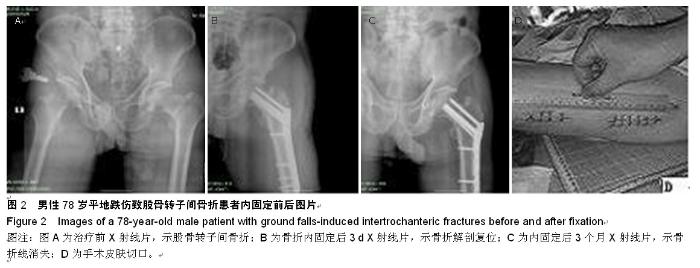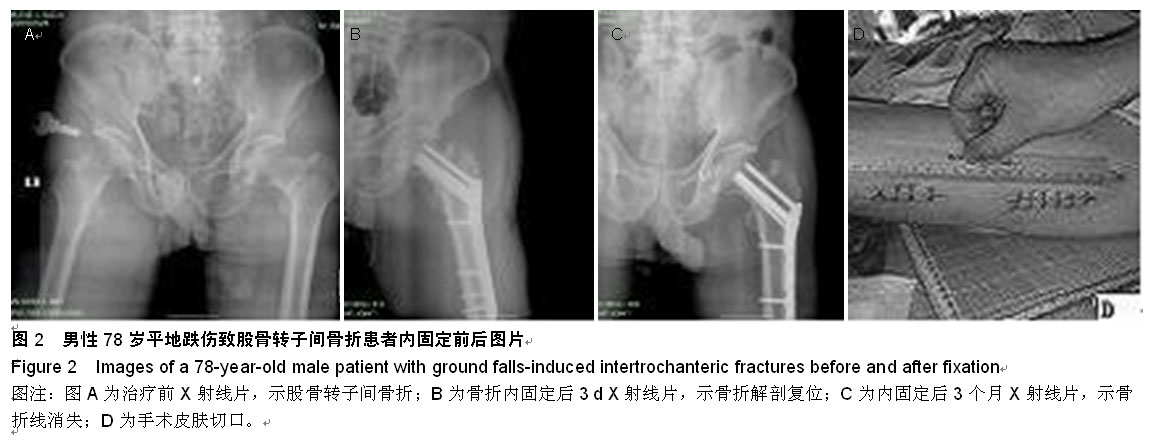| [1] 文浩,段戡,袁长深,等.股骨近端锁定钢板与动力髋螺钉修复股骨转子间骨折的系统评价[J].中国组织工程研究,2014,18(35): 5715-5722.
[2] 马洪良,彭军,陈懿等.解剖型钢板与动力髋螺钉治疗股骨转子间骨折的Meta分析[J].中国组织工程研究,2013,17(43): 7602-7609.
[3] 徐厚高.股骨近端防旋髓内钉与动力髋螺钉修复老年股骨转子间骨折的比较[J].中国组织工程研究,2014,18(35):5611-5615.
[4] 沈宏江,郭亮.股骨近端髓内钉与动力髋螺钉内固定修复老年股骨转子间骨折:12个月随访并发症发生率比较[J].中国组织工程研究,2014,18(44):7146-7150.
[5] Wang J, Wang Y, Liu WD, et al. Hip fractures in Hefei, China: the Hefei osteoporosis project. J Bone Miner Metab. 2014; 32(2):206-214.
[6] Shen J, Luo F, Sun D, et al. Mid-term results after treatment of intertrochanteric femoral fractures with percutaneous compression plate (PCCP). Injury. 2014;pii: S0020-1383(14) 00200-0029.
[7] Saarenpaa I. Heikkinen T, Ristiniemi J. Functional comparison of the dynamic hip screw and the Gamma locking nail in trochanteric hip fractures: a matched-pair study of 268 patients. Int Orthop. 2009;33(1): 255-260.
[8] Peleg K, Rozenfeld M, Radomislensky I,et al.Policy encouraging earlier hip fracture surgery can decrease the long-term mortality of elderly patients. Injury. 2014;45(7): 1085-1090.
[9] 梁昌详,郑晓青,昌耘冰,等.精确定位防旋髓内钉置入治疗股骨转子间骨折[J].中国组织工程研究,2014,18(17):2685-2690.
[10] 陈兴华,刘涛,黄珍谷,等.长、短股骨近端防旋髓内钉固定股骨转子间骨折的对比[J].中国组织工程研究,2014,18(4):595-600.
[11] 佘远时,陈广祥,陈广东,等.可灌注骨水泥动力髋螺钉内固定修复骨质疏松股骨转子间骨折的优势[J].中国组织工程研究,2014, 18(26):4158-4162.
[12] 周强,陆骅,俞思明,等.动力髋结合转子稳定钢板与Gamma钉内固定治疗股骨转子间骨折的比较[J].中国组织工程研究,2014, 18(9):1441-1452.
[13] 李靖扬,周瑜博,乔为民,等.四种金属植入物内固定修复老年股骨转子间骨折的比较[J].中国组织工程研究,2014,18(26): 4163-4167.
[14] 李岩,王东,孙海钰,等.髓内与髓外系统骨钉置入治疗不稳定股骨转子间骨折的综合效果评价[J].中国组织工程研究,2013,17(35): 6254-6260.
[15] 王亚平,路通.人工髋关节置换与股骨近端髓内钉治疗股骨转子间骨折的比较[J].中国组织工程研究,2013,17(52):8961-8966.
[16] 施向春,梁家龙,颜斌,等.股骨近端锁定接骨板治疗股骨转子间及转子下骨折[J].中华创伤杂志,2013,29(8):766-767.
[17] 张先军,陈洋.股骨近端锁定钢板治疗不稳定股骨转子间骨折[J].临床骨科杂志,2014,17(1):73-74.
[18] 施田宝,袁龙华,雷卫军,等.股骨近端锁定加压钢板治疗股骨转子间骨折[J].临床骨科杂志,2013,16(6):662-663.
[19] 刘苏,徐又佳,王创利,等.微创经皮钢板固定法结合锁定加压钢板治疗老年股骨转子间骨折的疗效[J].中国老年学杂志,2013, 33(1):61-63.
[20] 周力,危杰,王满宜.亚洲型髓内髋螺钉系统治疗股骨转子间骨折的早期疗效[J].中华创伤骨科杂志,2011,13(3): 286-288.
[21] Strauss E, Frank J, Lee J, et al. Helical blade versus sliding hip screw for treatment of unstable intertrochanteric hip fractures: a biomechanical evaluation. Injury. 2006;37(10): 984-989.
[22] Aktselis I, Kokoroghiannis C, Fragkomichalos E, et al. Prospective randomised controlled trial of an intramedullary nail versus a sliding hip screw for intertrochanteric fractures of the femur. Int Orthop. 2014;38(1):155-161.
[23] Shen L, Zhang Y, Shen Y, et al. Antirotation proximal femoral nail versus dynamic hip screw for intertrochanteric fractures: a meta-analysis of randomized controlled studies. Orthop Traumatol Surg Res. 2013;99(4):377-383.
[24] 赵耀杰,陈军,李凯军,等.防旋股骨近端髓内钉与动力髋螺钉治疗股骨转子间骨折疗效比较[J].临床骨科杂志,2014,17(2): 161-163,164.
[25] 范远俊,向阳,李正云,等.改进型防旋股骨近端髓内钉与人工股骨头置换术治疗老年股骨转子间骨折疗效比较[J].创伤外科杂志, 2014,16(3):264-264,266.
[26] 杨翔,赵友明,陈林,等.Trigen髓内钉与动力髋螺钉治疗股骨转子间骨折合并同侧股骨颈骨折的临床疗效比较[J].中华创伤杂志, 2014,30(6):564-568.
[27] 黄强,沈杰,王序全,等.3种内固定器治疗股骨转子间骨折的创伤性比较[J].中华创伤杂志,2014,30(3):232-234.
[28] 魏海永,王刚祥.股骨近端髓内钉治疗老年股骨转子间骨折[J].临床骨科杂志,2013,16(1):108-108.
[29] 曾宪林,周忠,蒋林.应用Gamma钉治疗股骨转子间骨折术后并发症发生因素的分析[J].中国修复重建外科杂志,2007, 21(1): 9-11.
[30] Bojan AJ, Beimel C, Speitling A, et al. 3066 consecutive Gamma Nails. 12 years experience at a single centre. BMC Musculoskelet Disord. 2010;26(11):133.
[31] Uzun M, Ertürer E, Oztürk I, et al. Long-term radiographic complications following treatment of unstable intertrochanteric femoral fractures with the proximal femoral nail and effects on functional results. Acta Orthop Traumatol Turc. 2009;43(6): 457-463.
[32] Takigami I, Matsumoto K, Ohara A, et al. Treatment of trochanteric fractures with the PFNA (proximal femoral nail antirotation) nails system-report of early results. Bull NYU Hosp Jt Dis. 2008;66(4):276-279.
[33] 石国栋,叶斌,陆洋阳,等.股骨近端防旋髓内钉治疗老年不稳定型股骨转子间骨折[J].临床骨科杂志,2013,16(1):54-56.
[34] Pu JS, Liu L, Wang GL, et al. Results of the proximal femoral nail antirotation(PFNA) in elderly Chinese patients. Int Orthop. 2009;33(5):1441-1444.
[35] Zha GC, Chen ZL, Qi XB, et al. Treatment of pertrochanteric fractures with a proximal femur locking compression plate. Injury. 2011;42(11):1294-1299.
[36] 李必奎,陈周兵,徐富生.股骨近端锁定钢板治疗股骨转子间骨折[J].中国修复重建外科杂志, 2011, 25(10):1273-1275.
[37] 季烈峰,陈巨坤,徐丁,等.股骨近端防旋髓内钉与解剖锁定钢板治疗老年股骨转子间骨折的疗效比较[J].中华创伤骨科杂志, 2014,16(8):727-730.
[38] 李劲松,徐振宇,吴珊,等.有限切开股骨近端锁定钢板内固定治疗老年人复杂股骨转子间骨折[J].中华创伤骨科杂志,2013, 15(2):171-172. |

